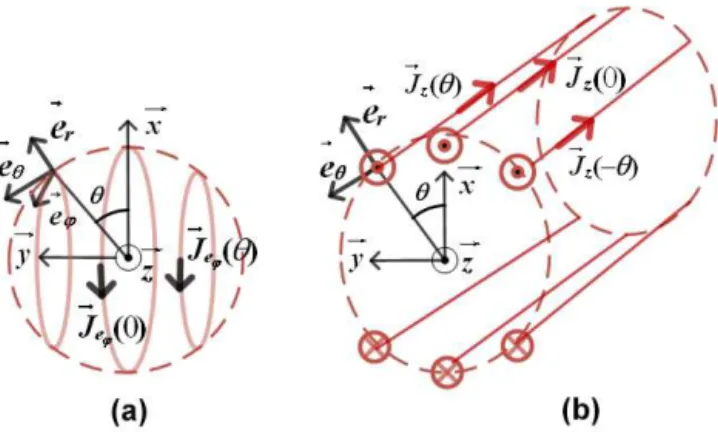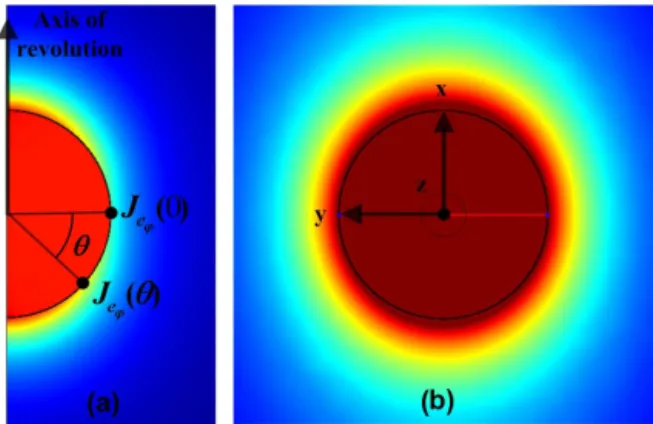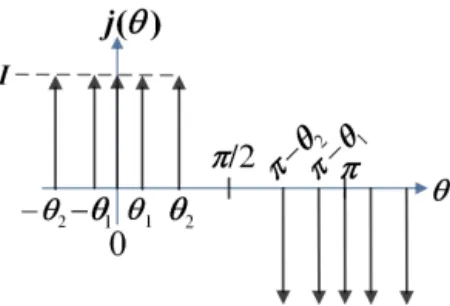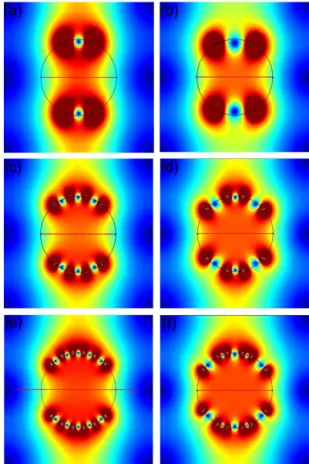The magnetic field homogeneity of coils by
means of the space harmonics suppression of
the current density distribution
Christophe Coillot1, Eric Nativel2, Michel Zanca1,3, and Christophe Goze-Bac1 1Laboratoire Charles Coulomb (L2C-UMR5221), BioNanoNMRI group, University of Montpellier,
Place Eugène Bataillon, 34095 Montpellier, France
2Institut d’Electronique et des Systèmes (IES-UMR5214), University of Montpellier,
Campus Saint-Priest, 34095 Montpellier, France
3Nuclear medicine, CMC Gui de Chauliac, University Hospital Montpellier,
34095 Montpellier, France
Correspondence to:Christophe Coillot (christophe_coillot@yahoo.fr)
Received: 31 May 2016 – Revised: 27 October 2016 – Accepted: 4 November 2016 – Published: 24 November 2016
Abstract. Electromagnetic coils are ubiquitously used in the modern world in motors, antennas, etc. In many applications (magnetic field coil calibration and nuclear magnetic resonance spectroscopy and imaging) there is a strong need for a homogeneous magnetic field. In this paper, we propose a simple modelling based on serial Fourier decomposition allowing the determination of the electrical conductor distribution to make the magnetic field homogeneous. The method is valid both for plane and axisymmetric geometries. The method allows the retrieval of the classical configurations of saddle coil for the plane geometry and Helmholtz coil for the axisymmetric one. The method is generalized for any number of electrical conductors and brings the perspective of new homogeneous magnetic resonance imaging (MRI) coil configuration.
1 Introduction
Electrical coils have had a long history since the pioneer works of Ampere and Tesla. Their emergence comes prob-ably from their ability to extend the fascinating properties of the magnetized matter by modulating their behaviour by means of electrical currents. Unfortunately, the magnetic field produced by electrical coils exhibits a strong depen-dance on the distance compared to the coil, since the mag-netic field produced by a coil vanishes when going away from the coil plane, while numerous applications require a homo-geneous one. This is the concern of nuclear magnetic reso-nance spectroscopy (NMR) and magnetic resoreso-nance imag-ing (MRI) where the homogeneity of coils is crucial for the staticB0magnetic field but also important for the radiofre-quency (RF) coil, which produces the B1RF field to excite and to detect the nuclear spin induction. This MRI coil homo-geneity, which has guided the present work, remains a major issue for the MRI experiment (Mispelter et al., 2006).
Usu-ally, MRI coil length should be smaller than a fraction of the wavelength (1/20) at the frequency of interest. When it is not the case, MRI coil should be segmented (Mispelter et al., 2006) to ensure that quasi-static magnetic field hypothesis is suitable. Our work will be examined based on this hypothe-sis. We will consider the 1 and 10 % homogeneity defined as the fraction of coil diameter, where the magnetic field inten-sity remains, respectively, within 1 and 10 % of its maximum value.
2 Homogeneous magnetic field coils: the cosine current distribution theorem
Figure 1.Current density distribution:(a)axisymmetric geometry in spherical coordinates,(b)plane geometry (infinite inzdirection)
in cylindrical coordinates. We adopt a unique angle notation for the two problems by substituting the usualϕ(in the cylindrical coordi-nates) byθ.
understand, in the following, the origin of this current den-sity distribution theorem.
The cosine distribution can be deduced from the Maxwell– Ampere equation (Eq. 1), which basically links the magnetic fieldHand the current densityJ.
h
×H=J (1)
We have to determine the current density component on the circumference of aR radius, alongz, for cylindrical
coordi-nates (see Fig. 1b), or alongeϕ, for spherical coordinates (see
Fig. 1a).
Since the current density has only a component along z
(following the Bolinger et al., 1988, case study), in cylindri-cal coordinates, Maxwell–Ampere equation becomes
1
r( ∂(rHϕ)
∂r −
∂Hr
∂ϕ )=Jz(θ, r). (2)
In spherical coordinates, Maxwell–Ampere equation be-comes
1
r( ∂(rHθ)
∂r −
∂Hr
∂θ )=Jeϕ(θ, r). (3)
Due to the equivalence between these two equations we will adopt a unique angle notation by substitutingϕ (in the cylindrical coordinates) withθ. Consequently, Eq. (2) is re-placed by
1
r( ∂(rHθ)
∂r −
∂Hr
∂θ )=Jz(θ, r). (4)
Next, by assuming a constant magnitude of the magnetic field (H, as depicted in Fig. 2), we getHr2+Hθ2=H2, while the x and y components of Hin cartesian coordinates are related to the ones in cylindrical (and spherical) coordinates:
H·x=Hrcos(θ)−Hθsin(θ)
H·y=Hrsin(θ)+Hθcos(θ).
Figure 2.Representation of the magnetic field componentsH,Hr
andHθin the cartesian and cylindrical coordinates. Spherical
coor-dinate representation is equivalent to the cylindrical one in a revo-lution near.
Then, by assuming a given direction of the magnetic field, for instanceH·x=0 (see Fig. 2), we deduce Hrcos(θ)=
Hθsin(θ) and consequentlyHr=Hsin(θ).
By solving Maxwell–Ampere equation atr=R(the term
∂(rHθ)
∂r vanishes) Eqs. (3) and (4) become, respectively,
Eqs. (5) and (6):
−R1 ∂H∂θr =Jeϕ(θ) (5)
− 1
R ∂Hr
∂θ =Jz(θ). (6)
Thus, we obtain the condition that must be fulfilled by the current density to produce a homogeneous magnetic field for coils of revolution with axisymmetric geometry (Fig. 1a) and infinite plane geometry (Fig. 1b), given respectively by Eqs. (7) and (8):
Jeϕ(θ)=J0cos(θ)eϕ (7)
Jz(θ)=J0cos(θ)z, (8)
whereJ0= −R1H.
Lastly, the simulation performed on a finite-element soft-ware, which allows the confirmation of this rule, illustrates the perfect homogeneity inside the coil obtained both for axisymmetric revolution geometry and 2-D plane when the magnitude of the current density is cosinusoidal along the circumference of a circle (see Fig. 3). In both cases, the cur-rent density direction is normal to the figure.
3 The cosine coils: a brief review
Figure 3.Magnetic field magnitude distribution of the ideal homo-geneous coil (assuming cos(θ) distribution of the current density along the circumference) performed on a numerical finite-element software: (a)case of a solid of revolution and (b)case of a 2-D plane infinite (alongz) geometry. The colour scale is related to the magnitude of the magnetic field. The homogeneity of the colour is related to the homogeneity of the magnetic field.
this purpose Everett tried to approach the ideal cosine current density distribution, and the authors suggested to approach the ideal sphere coil by placingN equally spaced turns (on the diameter projection) separated by a distanceb, each turn being flown by the same current (see Fig. 4). The main vari-able of the problem was the parameterization (through a pa-rameterp) of the last turn position, namelypb. Then sophis-ticated analytic calculations were performed to get the opti-mump value (0< p <1), with respect to a magnetic field homogeneity criterion. Finally the coil, let us call it Everett’s coil, was constructed but the conclusion concerning the ef-ficiency was mitigated. Surprisingly, the alternative solution to produce a cosine current distribution, namely by adjusting the current density in the conductors of the sphere coil, was not evoked.
Later on, in the field of MRI coils, there were numerous efforts to enhance the homogeneity of the coil. The saddle coil, which is the extruded plane version of the Helmholtz coil, was generalized because of its convenience with re-spect to the NMR experience (Hoult and Richards, 1976). A very important enhancement of the saddle coil was then proposed by Hayes et al. (1985) through the birdcage res-onator. This famous MRI coil consists in multiple conduc-tors equally spaced (on the angular point of view). Capac-itors are used to produce a phase shift of the current along the circumference to approach the ideal cosine distribution (as given by Eq. 8). The Bolinger idea was to apply Everett’s coil strategy to the saddle coil (Bolinger et al., 1988). How-ever, Bolinger simplified the original problem by assuming
Nequally spaced conductors, without thepparameter. A ho-mogenous image about four-fifths of the internal volume of the coil was reported. Nevertheless, a quantitative and rele-vant method to quantify homogeneity of MRI coils by means of field histogram proposed by Yang et al. (1994) has
high-Figure 4.Bolinger’s coil: the turns, distributed along the circum-ference (placed around the cylinder at anglesθ (NB the comple-mentary angle8was used in Bolinger’s paper)), are equally spaced projected along the diameter (b=2R/(2N+1)).
lighted the disappointing homogeneity reached by Bolinger’s coil.
On the other hand, an improvement of the birdcage was invented by Harpen (1991), who proposed a spherical RF coil where the turns were equally spaced (by equal an-gle). The cosine current distribution (as given by Eq. 7) was reached by an adequate distribution of the capacitances:
C(θ)=C0/sin(θ).
Lastly the four coils proposed by Hoult and Deslaurier (1990) gave a significant improvement of the Helmholtz coil, at the expense of sophisticated computation, where both con-ductor locations and current flowing through the coils are computed to improve the homogeneity. The four coils require a specific ratio between the current flowing into the inner and outer pairs of conductor.
4 The Bolinger cosine coil paradox
As proposed initially by Clarck (1938) and Everett and Ose-meikhian (1966), for axisymmetric revolution, and revisited by Bolinger, for plane geometry, the cosine coil is such that wire positions are found by a geometric construction where intervals of equal length along the diameter are projected onto the circumference (Bolinger et al., 1988), as shown in Fig. 4. Thus, forNturns (or conductors), the space between turns is given byb=2R/(N+1) while the position of the
Figure 5.Electrical conductors of unknown angular positions (θ), flown by the same currentI, distributed along the circumference.
5 Spatial harmonics of the current distribution produced by the discrete conductors coil
We now go back to the original problem: how to distribute the electrical conductors, flown by the same current, along the circumference to get a homogeneous magnetic field inside the coil.
The problem, as illustrated in Fig. 5, is equivalent to seek-ing the optimum angle position (θ) of each conductor.
Let us now represent the current distribution of the coil of Fig. 5 in a more convenient way where electrical conductors are represented by means of Dirac distributions (see Fig. 6). To this end, we use a one-dimensional Dirac distribution (δ) as a function of the angleθso thatδhas the unit rad−1and such asR2π
0 δ(θ)dθ=1. Next, we considerN pairs of con-ductors infinitely thin, flown by the same currentI, and the
nth conductor is defined by its angle position θn (Fig. 6).
For such a conductor, we use a current density distribution
j(θ)= ±I δ(θ−θn) inA/rad, where the±sign depends on
the direction of the current density flow. Finally, the current density distribution of the coil of Fig. 5 is expressed as
j(θ)=I δ(θ)−I δ(θ−π)+6nN=1(I δ(θ−θn)+I δ(θ+θn)
−I δ((θ−θn)−π)−I δ((θ+θn)−π)). (9)
The current density distribution is an even function, and the terms δ(θ) and δ(θ−π) are related to the central coil. In the case of an even-turn number (namely without the cen-tral conductor at x=0), these terms can be omitted. Next, due to the symmetries of the current density distribution (see Fig. 6), the calculation of the Fourier series (a(2k−1)) coeffi-cients is simplified and we getkas an integer:
a(2k−1)= 2
π
π/2 Z
−π/2
j(θ)cos((2k−1)θ)dθ. (10)
Figure 6.Representation of the space current density distribution.
For the coils having a central conductor we get k as an integer:
a(2k−1)odd= 2I
π 6
N
n=1(1+2cos((2k−1)θn)), (11)
and the current density function is expressed as
j(θ)odd=6k∞=1
6nN=12I
π (1+2cos((2k−1)θn))
×cos((2k−1)θ). (12)
For the coils without the central conductor we get
a(2k−1)even= 4I
π 6
N
n=1cos((2k−1)θn), (13)
and the current density function is expressed as
j(θ)even=6k∞=1
6nN=14I
π cos((2k−1)θn)
×cos((2k−1)θ). (14)
Equations (12) and (14) will be the basis of the space har-monic suppression (SHS) method. The Fourier series decom-position has an infinite number of harmonics. Each harmonic can be cancelled by means of a supplementary conductor. To reach a perfect homogeneity all the harmonics should be cancelled and consequently an infinite number of conduc-tors would be required. In such a “theoretical” case, the infi-nite discrete conductor distribution will be equivalent to the perfect homogeneous coil (i.e. with an ideal cosine current density distribution) whose simulation result is reported in Fig. 3.
5.1 Two-turn coil
Let us study the case of the two-turn coil (i.e. one pair of turns:N=1). In such a case, the condition to cancel the first harmonic (k=2), from Eq. (14), is expressed as
cos(3θ1)=0, (15)
which obviously leads to θ1=π/6, namely the Helmholtz condition for the axisymmetric problem and the saddle coil condition for the plane geometry (Hoult and Richards, 1976). On the other hand the Bolinger cosine coil condition (the turns are equally spaced projected along the diameter) leads tob=2R/3. Under this condition the obtained homogeneity is very poor (see Fig. 7).
5.2 Three-turn coil: comparison with Maxwell coil The Maxwell coil is a famous homogeneous coil with odd turns (three turns). This coil is defined by cos(θ)=√4/7 (∼ 40.89◦) andI /I0=49/64, whereI0 is the current into the central coil whileI is the current on the lateral coils.
Let us now study the three-turn SHS coil. Thus, we just have to solve 1+2cos(3θ1)=0, which leads toθ= ±49π+ m23π, wheremis an integer. It is noticeable that the first an-gle solution (θ=49π) leads to a good magnetic field homo-geneity (the simulation results are not presented here) while it leads to a very poor efficiency coil because of the reduced magnitude of the fundamental contribution (namely the term 1+2cos(θ1)=0). Thus, each solution ofθmust be evaluated with respect to the fundamental magnitude. In this case, the solutionθ=169π (=40◦) leads to the higher value of the fun-damental. Finally, let us compare the three-turn SHS coil to the Maxwell coil. From numerical simulation, we can extract the 1 and 10 % homogeneity ranges. First, in the context of an infinite plane geometry coil (see Table 1), the three-turn SHS coil exhibits a slightly better 1 and 10 % homogeneity than the Maxwell one.
Second, in the context of an axisymmetric geometry, which corresponds to the validity domain of the Maxwell coil, the 1 and 10 % homogeneity of the SHS, as summarized by Table 2, are better. Nevertheless, the three-turn SHS coils exhibit small fluctuations of the magnetic field in the centre part of the coil (<1 %) while it is rigorously homogeneous for the Maxwell coil. However, as emphasized by Mispelter
tween the Hoult–Deslauriers coil and the four-turn SHS coils. Coil type Hoult–Deslauriers coil Four-turn SHS 1 % homogeneity 0.56 0.51 10 % homogeneity 0.78 0.77
et al. (2006), the RF MRI coil homogeneity is not extremely stringent, typically about±5 %.
5.3 Four-turn coil
Let us now study the case of two pairs of turns (i.e.N=2). The conditions to cancel the first and second harmonics are
cos(3θ1)+cos(3θ2)=0
cos(5θ1)+cos(5θ2)=0, (16)
which leads toθ1=π/15 andθ2=4π/15. On the one hand the Bolinger cosine coil condition is b=2R/5; its homo-geneity is slightly improved (with respect to the two-turn Bolinger coil) but remains still far from the one obtained for four-turn SHS coil. On the other hand, it is interesting to no-tice that the Hoult and Deslauriers coil condition (see Hoult and Deslaurier, 1990) for the axisymmetric problem led to anglesǫ=0.699 andψ=1.282 (we report here the angle notation used in Hoult and Deslauriers’s paper) defined with respect to thex axis (see Fig. 7), which becomes the follow-ing in our notation context:ψ′=π/2−ψ=0.288≈θ1and
SHS coil Two turns Four turns Six turns 1 % homogeneity 0.33 0.51 0.61 10 % homogeneity 0.58 0.77 0.83
5.4 Six-turn coil
Let us now study the caseN=3. In such a case, the condi-tion to cancel the harmonics are expressed as
cos(3θ1)+cos(3θ2)+cos(3θ3)=0
cos(5θ1)+cos(5θ2)+cos(5θ3)=0 (17) cos(7θ1)+cos(7θ2)+cos(7θ3)=0.
The angle solutions (in radians) of Eq. (17) are easily found by means of a numerical minimization algorithm: [θ1= 0.2035,θ2=0.4537,θ3=0.977]. A Newton algorithm (sim-ilar to the one described in Coillot et al., 2007) was used, but a genetic algorithm would be best suited for a higher turn number. On the other hand, the angle position of the con-ductors of the Everett–Bolinger six-turn coil will be [θ1EB=
0.143, θ2EB=0.443, θ3EB=0.796]. Here again, the homo-geneity of the Everett–Bolinger coil, as depicted in Fig. 7, is far from the one obtained by the SHS coil. One can notice that the SHS coil will not obey the Everett cosine coil rule (even if the last turn position is used as a variable of theb dis-tance), since the positions on thexaxis of the first and second turns of the six-turn SHS coil (respectively sin(θ1)=0.202 and sin(θ2)=0.438) are not at multiple distances (b/2 and
b+b/2).
All the presented results are mostly qualitative and a quan-titative study on the homogeneity should be performed to ap-preciate the benefit of the proposed method. To this aim, on the one hand we compare, in Fig. 8, the magnetic field pro-file alongy axis for the different coils. On the other hand, we propose to perform quantitative comparisons by means of two homogeneity criteria: the 10 % homogeneity criterion (which is sufficient for RF MRI coil; Mispelter et al., 2006) and the 1 % criterion (which is well adapted for stringent de-sign as for the magnetic field calibration devices). Table 4 summarizes the obtained homogeneity for the two types of coils.
5.5 Generalization of the method for even-turn coil In the context of anN-turn coil pairs, we will have to deter-mine theNangles satisfying theNharmonic suppression, as given by the set ofNequations:
Figure 7. Magnetic field homogeneity of the Everett–Bolinger coil:(a),(c)and(e), respectively, for two, four and six turns. The SHS coil:(b),(d)and(f), respectively, for two, four and six turns.
Figure 8.Magnetic field homogeneity profile on thexaxis, com-parison between Everett–Bolinger coil and SHS coil for two, four and six turns.
6nN=1(cos(3θn))=0(k=1)
. . .
6nN=1(cos((2j−1)θn))=0(k=j) (18)
. . .
1+6nN=1(cos((2j−1)θn))=0(k=j) (19)
. . .
1+6nN=1(cos((2N−1)θn))=0(k=N).
6 Discussion
The proposed method neglects the real size of the conduc-tor. Thus, the accuracy of the method could be enhanced by taking into account the real conductor size in the Fourier se-ries decomposition. Nevertheless, at high frequency, where skin effect is not negligible, the occurrence of the proximity effect could affect the current distribution in conductors and modify the homogeneity. Lastly, the method is also applica-ble for the odd coil turns case even if we have focused on an even one. However, it is noticeable that simulation results be-tween extruded geometry and axisymmetric one are slightly different.
As an alternative method, we could consider minimizing all the harmonic contribution, but it seems that the harmonic by harmonic minimization is much more reliable. The rea-son probably comes from the fact that the Dirac conductor is not real and the contribution of the high-order harmonics is not negligible while, in practice, the high space harmonics effect should decrease rapidly. The superiority of the Hoult and Deslauriers coil, using a supplementary variable (namely the current ratio between coils), could inspire an extension of the SHS method).
In the context of odd coil, we have seen in a case study that, at the same time that the harmonics are minimized, we should maximize the fundamental. So, rigorously, each solu-tion should satisfy both to the suppression of harmonics and the maximization of the fundamental.
One could ask what the benefits or disadvantages of an en-hanced homogeneity would be. Let us consider the case of a calibration coil. For a given homogeneous volume the radius of the coil can be reduced. It follows that its mass and cost will be reduced too. This benefit was pointed out by Everett and Osemeikhian (1966).
Finally, in the context of MRI coils, the resulting image homogeneity will depend on (as discussed in Coillot et al., 2016) the RF coil configuration (emitter, transceiver, or both emitter and a transceiver), the magnetic field homogeneity inherent to the coil geometry and the type of running MRI sequence.
Everett, for the axisymmetric coil, and Bolinger, for extruded geometry, to approach the cosine current density distribution by allocating the conductor along a circle circumference was luminous. Nevertheless, the intuitive rule they proposed to build their coils was not really relevant to improving homo-geneity. The SHS method allows the exact and easy determi-nation of the position of the conductor even for a high turn number. That opens up a new perspective in the field of MRI, especially by revisiting the Bolinger cosine coil.
Acknowledgements. The authors would like to thank the ref-erees for their deep and conscientious reading. Their constructive remarks clarified and improved the mathematical formulation of the problem.
Edited by: B. Jakoby
Reviewed by: three anonymous referees
References
Bolinger, L., Prammer, M. G., and Leigh, J. S.: A Multiple-Frequency Coil with a Highly UniformB1Field, J. Magn.
Re-son., 81, 162–166, 1988.
Clark, J. W.: A new method for obtaining a uniform magnetic field, Rev. Sci. Instrum., 9, 320–322, 1938.
Coillot, C., Moutoussamy, J., Leroy, P., Chanteur, G., and Roux, A.: Improvements on the Design of Search Coil Magnetometer for Space Experiments, Sens. Lett., 5, 167–170, 2007.
Coillot, C., Sidiboulenouar, R., Nativel, E., Zanca, M., Alibert, E., Cardoso, M., Saintmartin, G., Noristani, H., Lonjon, N., Lecorre, M., Perrin, F., and Goze-Bac, C.: Signal modeling of an MRI rib-bon solenoid coil dedicated to spinal cord injury investigations, J. Sens. Sens. Syst., 5, 137–145, doi:10.5194/jsss-5-137-2016, 2016.
Everett, J. E. and Osemeikhian, J. E.: Spherical coils for uniform magnetic fields, J. Sci. Instrum., 43, 470–474, 1966.
Harpen, M. D.: The Spherical Birdcage Resonator, J. Magn. Reson., 94, 550–556, 1991.
Hayes, C. E., Edeutein, W. A., Schenck, J. F., Mueller, O. M., and Eash, M.: An Efficient Highly Homogeneous Radiofrequency Coil for Whole-Body NMR Imaging at 1.5T, J. Magn. Reson., 63, 622–628, 1985.
Hoult, D. I. and Deslaurier, A.: High-Sensitivity and HighB1
Ho-mogeneity Probe for Quantitation of Metabolites, Magn. Reson. Med., 16, 411–417, 1990.



